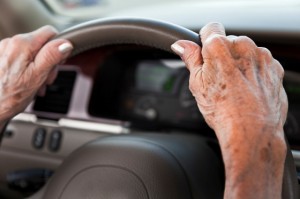There have been a number of highly publicised cases of elderly people driving “badly”, for example driving the wrong way on a motorway or at 9mph on a dual carriageway. Such cases have caused people to question the existing licensing rules for elderly drivers. Currently, older adults simply need to re-apply when they reach the age of 70 years old and inform the DVLA if they have any medical condition that may influence their driving abilities. Some have suggested that additional tests may be needed to reduce the risks of elderly drivers, but first it’s necessary to understand why the elderly are more collision prone.
 There are some obvious reasons why older adults might be more at risk of causing a crash; deteriorating eyesight and motor control are two factors that may contribute, but they by no means provide a complete explanation. Indeed, much of the increased risk can be explained in terms of the psychological changes and cognitive decline that occurs in later life.
There are some obvious reasons why older adults might be more at risk of causing a crash; deteriorating eyesight and motor control are two factors that may contribute, but they by no means provide a complete explanation. Indeed, much of the increased risk can be explained in terms of the psychological changes and cognitive decline that occurs in later life.
Driving is a highly complex activity, requiring the driver to allocate their attention to a range of different tasks but attention is one aspect of cognitive processing that declines in later life. Researcher Liisa Hakamies-Blomqvist has suggested that this may be one of the main contributory factors.
She asked older and middle-aged drivers whether they were aware of the risk of a collision before it occurred. For the middle-aged drivers 74% were aware, but only 66% of the older adults were aware. It seems that older drivers may find it difficult to monitor and pay attention to all the different aspects of driving. They are therefore not likely to notice a potential danger and would be unable to attempt to avoid an incident.
The cognitive decline that many older adults experience may also contribute to increased driving risk. Professor Timothy Salthouse from the University of Virginia is one of the leading experts in cognitive ageing. He has suggested that one of the main consequences of cognitive ageing is a decrease in the speed with which information can be processed. This means that older adults may take longer to notice a potential hazard and to then respond to it. Salthouse has also suggested that older adults find it difficult to process multiple pieces of information at the same time. Consequently they may tend to concentrate on one aspect of driving at a time. Given how rapidly things occur when driving, it’s easy to imagine how challenging driving would be if you could only pay attention to one thing at a time and slowly process that information before moving on to process the next piece.
Although there are a number of reasons why drivers become more accident prone in old age, there are actually some aspects of driving in which older drivers are less risky. For instance, the elderly are far less likely to drive after consuming alcohol and are more likely to wear prescription glasses whilst driving. Also, older adults are more likely to drive in a generally cautious manner. They are also less likely to speed, however this might also become a risky behaviour if speed drops too low, as has occurred in a number of cases.
While it’s clear that elderly drivers may be more accident prone, we do not know exactly why this is the case, and there are likely to be multiple reasons that contribute to the increased accident risk. How might we reduce this risk? There appear to be two strategies, which are not necessarily mutually exclusive. First, it may be possible to provide training to elderly drivers that can make them aware of the possible risks and to teach them techniques that help them to drive safely. Second, methods might be developed that allow the licensing authorities to identify elderly drivers that are more “at risk” of causing a collision. Such identification may then feed into decisions about renewing the driving licence of older adults.
Dr Victoria Bourne (BA Hons, DPhil)
Consultant to Driving Risk Management Limited




